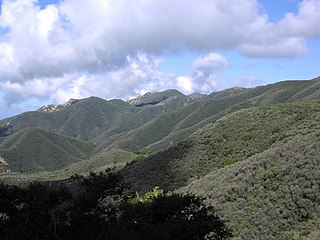
Chaparral is a shrubland plant community and geographical feature found primarily in California, in southern Oregon, and in the northern portion of the Baja California Peninsula in Mexico. It is shaped by a Mediterranean climate and infrequent, high-intensity crown fires. Chaparral features summer-drought-tolerant plants with hard sclerophyllous evergreen leaves, as contrasted with the associated soft-leaved, drought-deciduous, scrub community of coastal sage scrub, found often on drier, southern facing slopes within the chaparral biome. Three other closely related chaparral shrubland systems occur in central Arizona, western Texas, and along the eastern side of central Mexico's mountain chains (mexical), all having summer rains in contrast to the Mediterranean climate of other chaparral formations. Chaparral comprises 9% of California's wildland vegetation and contains 20% of its plant species.
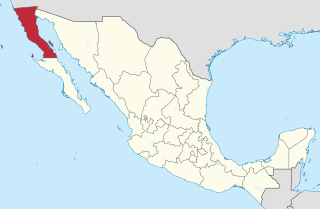
Baja California, officially the Free and Sovereign State of Baja California, is a state in Mexico. It is the northernmost and westernmost of the 32 federal entities of Mexico. Before becoming a state in 1952, the area was known as the North Territory of Baja California. It has an area of 70,113 km2 (27,071 sq mi) and comprises the northern half of the Baja California Peninsula, north of the 28th parallel, plus oceanic Guadalupe Island. The mainland portion of the state is bordered on the west by the Pacific Ocean; on the east by Sonora, the U.S. state of Arizona, and the Gulf of California; on the north by the U.S. state of California; and on the south by Baja California Sur.

Tijuana Municipality is a municipality in the Mexican state of Baja California. Its municipal seat is located in the city of Tijuana. According to the 2020 census, the municipality had a population of 1,922,523. Luis Arturo González Cruz of the MORENA is the current municipal president. The municipality comprises the largest part of the Tijuana metropolitan area.
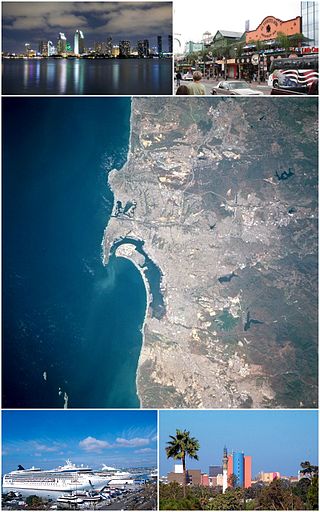
San Diego–Tijuana is an international transborder agglomeration, straddling the border of the adjacent North American coastal cities of San Diego, California, United States and Tijuana, Baja California, Mexico. The 2012 population of the region was 4,922,723, making it the largest bi-national conurbation shared between the United States and Mexico, the second-largest shared between the US and another country. In its entirety, the region consists of San Diego County in the United States and the municipalities of Tijuana, Rosarito Beach, and Tecate in Mexico. It is the third most populous region in the California–Baja California region, smaller only than the metropolitan areas of Greater Los Angeles and the San Francisco Bay Area.

Ornithostaphylos is a monotypic plant genus which contains the single species Ornithostaphylos oppositifolia, commonly known as the Baja California birdbush or Baja California manzanita. A large, evergreen shrub in the heather family, this species is near-endemic to northwestern Baja California, with a small population just north of the border in San Ysidro, California. It produces a much-branched inflorescence of white, urn-shaped flowers, and has leathery leaves that appear opposite or in whorls. These characteristics separate it from its close relatives in the region, which include manzanitas (Arctostaphylos), summer holly (Comarostaphylis) and mission manzanita (Xylococcus).
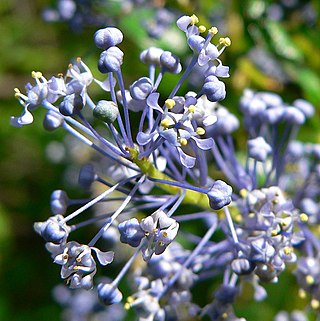
Ceanothus cyaneus is a species of flowering shrub in the genus Ceanothus known commonly as the San Diego buckbrush and Lakeside ceanothus. This species is found in the Peninsular Ranges of San Diego County, California, and known from one occurrence in Baja California. It is characterized by brilliant blue flowers, glossy green foliage, and is regarded as one of the most beautiful members of the genus.
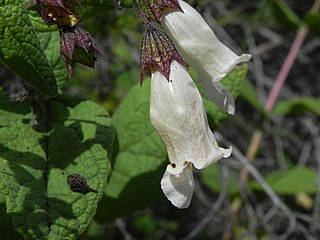
Lepechinia cardiophylla is an uncommon species of flowering plant in the mint family known by the common names Santa Ana pitcher sage and heart-leaved pitcher sage. A broad-leaved fragrant shrub, it has distinct pitcher-shaped flowers. It is native to the Peninsular Ranges and found in the Santa Ana Mountains of Southern California, a few locations in San Diego County, and some of the coastal mountains of northern Baja California. Few populations of the plant are known and many of them are located in areas that are threatened by development and other human activity.

Lepechinia ganderi is a rare species of perennial shrub in the mint family known by the common name San Diego pitcher sage or Gander's pitcher sage. An aromatic plant with white to lavender flowers, this species is only known from southern San Diego County in California and a small portion of Baja California, occurring on chaparral or coastal sage scrub in metavolcanic soils. Because of its limited range, it is under threat from growing urbanization and increased fire frequency.
Federal Highway 3 is a tollfree part of the federal highway corridors. One segment connects Tecate to Ensenada in Baja California. This segment ends at its junction with Fed. 1 at El Sauzal Rodriguez, just a little north of Ensenada. This segment of the highway is 112 kilometers (70 mi) long.

The San Ysidro Mountains are a mountain range in southern San Diego County, California and Baja California, Mexico. The mountains are a rugged coastal foothill range of the Peninsular Ranges system. Major peaks include the highest summit of the range, Otay Mountain, and the Cerro San Isidro which forms the southern extrusion of the range on the Mexican side of the border. The majority of the range is within the Otay Mountain Wilderness Area, in the United States.

Ceanothus verrucosus is a species of shrub in the family Rhamnaceae known by the common names wart-stem ceanothus, barranca brush, coast lilac and white coast ceanothus. It is endemic to northwestern Baja California and San Diego County, where it grows in coastal sage scrub and coastal succulent scrub habitats. It is considered a rare species north of the international border, as most of the valuable coastal land that hosts this plant in the San Diego area has been claimed for development. In California, several extant populations still remain scattered around the region, such as one protected at Torrey Pines.
Valle de las Palmas is located between two hamlets Espuela and Seco in the municipalities of Tijuana and Tecate, Baja California, Mexico. It is the site of a long-term planned urban development which would take advantage of proximity to the existing cities of Tijuana to the north west and Mexicali to the north east to create a similar sized city of one million people by the year 2030, on Mexican Federal Highway 3 around an existing industrial park and university campus Unidad Valle De Las Palmas. The first project in Valle de las Palmas, named Valle San Pedro, is proposed by the Mexican Federal Government, the State of Baja California, Urbi and Banobras. It has been certified as the first Integral Sustainable Urban Development or DUIS in Mexico, which establishes criteria in collaboration with Interamerican Development Bank IDB to evaluate projects that will receive inter-secretarial technical support and public investment. The locality reported a population of 1,860 inhabitants in the 2010 federal census. It is located at an altitude of 282 m. above sea level.

Unidad Valle de las Palmas is a formal extension of the Autonomous University of Baja California, belonging to the Campus Vicerectorship of Tijuana, located on the Tijuana-Tecate highway, near the height of the Carrizo Dam. In 2009, the academic unit will have new educational offerings in Health Sciences, Design, and Engineering Sciences.

The California coastal sage and chaparral is a Mediterranean forests, woodlands, and scrub ecoregion located in southwestern California and northwestern Baja California (Mexico). It is part of the larger California chaparral and woodlands ecoregion.

The Autonomous University of Baja California, Tijuana is one of three main campuses of the Autonomous University of Baja California (UABC), located in the Otay Centenario borough of Tijuana, Baja California state, México. It is a public research university.
The Autonomous University of Baja California (UABC) (Spanish: Universidad Autónoma de Baja California) is a public institution of higher education in Baja California. Established in 1957, UABC has its headquarters located in the city of Mexicali.

The Otay Mountain Wilderness is a U.S. Wilderness Area located in San Diego County, California, 12 miles east of the city of Otay Mesa and just north of the Mexican border. Some parts of the wilderness area rise quickly from sea level, reaching a peak of just over 3,500 feet (1,100 m) at the summit of Otay Mountain.

McGinty Mountain is a gabbroic mountain located in San Diego County, California near Jamul. Because of the gabbroic soil, the mountain supports numerous rare and endemic plant species, including half of the California's population of the Dehesa nolina. The mountain belongs to an ecological preserve collectively managed by The Nature Conservancy, the California Department of Fish and Wildlife, and the San Diego National Wildlife Refuge. The mountain is accessible through a 4.7 mi (7.6 km) long out-and-back hiking trail.

Arctostaphylos glandulosa subsp. crassifolia is a rare perennial shrub, a subspecies of manzanita within the heather family commonly known as the Del Mar manzanita. It is narrowly endemic to the sandstone coastal terraces of San Diego County and northwestern Baja California. It is a burl-forming evergreen shrub typically found growing in a rambling habit on poor soils and hardpan. From December to February, white to pink urn-shaped flowers decorate its foliage, giving way to small fruits. It is listed as endangered and is threatened by land development, invasive species and modifications to the natural fire regime.
Arctostaphylos bolensis is a species of perennial shrub in the heather family commonly known as the Cerro Bola manzanita. This species of manzanita is characterized by an erect habit, pendent panicles and the lack of a burl. It is a prolific bloomer, and when in blossom, it is enshrouded in white to pink urn-shaped flowers. This species is endemic to the Cerro Bola, and possibly the Cerro Italia, two mountain ranges southwest of the Valle de Las Palmas in northern Baja California.


















